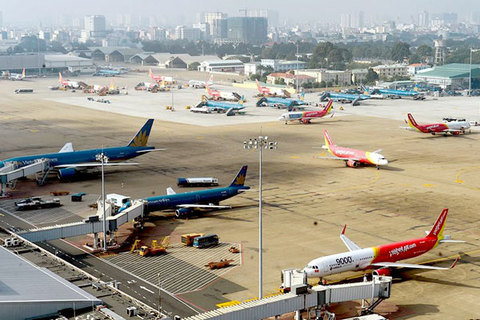
From January to June, ACV served 37 million domestic visitors corresponding to the growth of passengers over the same period of 7.5 per cent. — Photo enternews.vn
After the Aviation Corporation of Viet Nam (ACV) equitised, assets at flight operations areas still belong to the State, leading to the failure of ACV to perform necessary maintenance, according to the analysis team of Bao Viet Securities Joint Stock Company (BVSC).
Currently, the runways at Noi Bai and Tan Son Nhat International Airports have deteriorated and could pose a threat to flight safety. Therefore, ACV and the Ministry of Transport (MoT) have tried to negotiate and unify the options as well as submitted to the Government to be able to repair and maintain the flight area soon.
There are three options submitted by the MoT. The first one is the Government will lease the flight areas and ACV will have to pay an annual rental fee to the State. The cost of investment and maintenance of the flight zone will be covered by the Government.
The second option is that ACV will participate in the bidding and prepay for flight zone assets. ACV is responsible for the operation, investment, and maintenance of these assets.
Thirdly, the State increases the ownership of ACV to 100 per cent and the State assigns flight zones to ACV for management and operation.
BVSC estimates that the second option is the most feasible, which helps the runways receive maintenance as quickly as possible thanks to ACV's experience and available capital, and this option is likely to be approved.
However, in terms of ACV's business activities, the growth of international and domestic visitors is slowing down. Accordingly, in the first six months of 2019, ACV recorded VND8.91 trillion (US$383.84 million) of revenue and over VND3.7 trillion after-tax profit, an increase of 12 per cent and 19.9 per cent year-on-year, respectively.
From January to June, ACV served 37 million domestic visitors corresponding to the growth of passengers over the same period of 7.5 per cent. This growth has improved slightly compared to 2018 but is still lower than the high growth period 2013-2016. This downtrend continued and recorded an increase in international arrivals to 13.4 per cent (in 2018 the growth in international arrivals was 21 per cent).
BVSC supposed that the growth of domestic passengers will continue to be around 7 per cent in the coming years due to the pivot to international airlines of low-cost airlines as well as the limitations of aviation infrastructure. — VNS